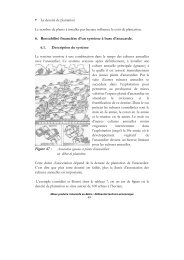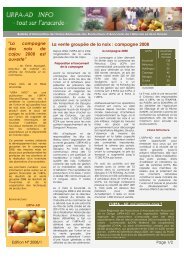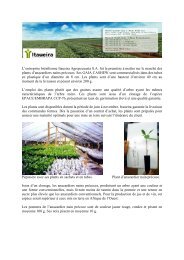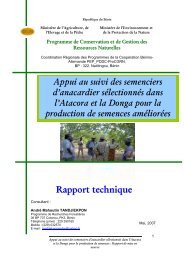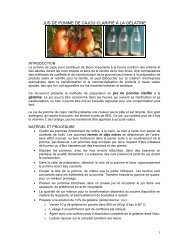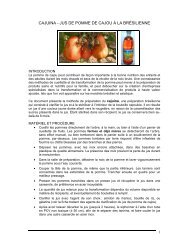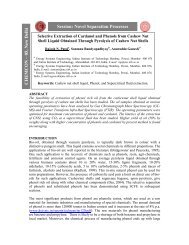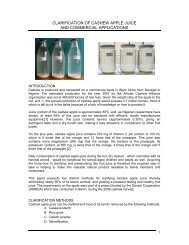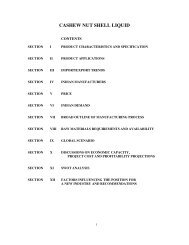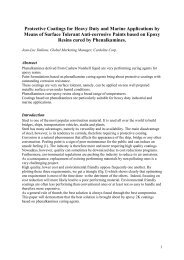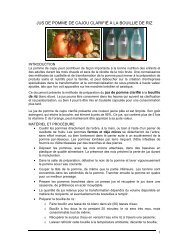Cashew Nuts in North Queensland Respond to Phosphorus and ...
Cashew Nuts in North Queensland Respond to Phosphorus and ...
Cashew Nuts in North Queensland Respond to Phosphorus and ...
You also want an ePaper? Increase the reach of your titles
YUMPU automatically turns print PDFs into web optimized ePapers that Google loves.
A u s t r a l i a<br />
<strong>Cashew</strong> <strong>Nuts</strong> <strong>in</strong> <strong>North</strong> <strong>Queensl<strong>and</strong></strong><br />
<strong>Respond</strong> <strong>to</strong> <strong>Phosphorus</strong><br />
<strong>and</strong> Sulfur Fertilizers<br />
By Noel J. Grundon<br />
<strong>Cashew</strong> nuts prefer a seasonally wet/dry, tropical climate <strong>and</strong> represent<br />
a new horticultural opportunity <strong>in</strong> northern Australia. <strong>North</strong><br />
<strong>Queensl<strong>and</strong></strong>, the <strong>North</strong>ern Terri<strong>to</strong>ry, <strong>and</strong> northern Western Australia<br />
have large areas with soils suitable for cashew. CSIRO L<strong>and</strong> <strong>and</strong><br />
Water has <strong>in</strong>itiated research at Dimbulah, <strong>North</strong> <strong>Queensl<strong>and</strong></strong>, <strong>to</strong><br />
<strong>in</strong>vestigate the fertilizer requirements of the crop.<br />
The research programme focused on (a) provid<strong>in</strong>g site-specific recommendations<br />
of the optimum fertilizer nutrient rates for susta<strong>in</strong>able<br />
economic yields of cashew nuts, <strong>and</strong> (b) m<strong>in</strong>imis<strong>in</strong>g long-term damage<br />
<strong>to</strong> the soil <strong>and</strong> water resources of the area from high <strong>in</strong>puts of fertilizer<br />
nutrients. Prelim<strong>in</strong>ary glasshouse nutrient omission studies identified<br />
deficiencies of nitrogen (N), phosphorus (P), <strong>and</strong> sulfur (S) <strong>in</strong><br />
cashew seedl<strong>in</strong>gs, while observations of nutritional disorders on fieldgrown<br />
trees <strong>in</strong>dicated that potassium (K) may be <strong>in</strong>adequate for<br />
mature trees <strong>in</strong> the field.<br />
Fertilizer field trials were <strong>in</strong>itiated us<strong>in</strong>g five rates of P, K, <strong>and</strong> S,<br />
commenc<strong>in</strong>g with four-year-old grafted cashew trees planted at a density<br />
of 200 trees/ha (i.e., 8 m row spac<strong>in</strong>g; 6 m spac<strong>in</strong>g with<strong>in</strong> rows).<br />
Trees were irrigated when required dur<strong>in</strong>g their flower<strong>in</strong>g <strong>and</strong> fruit<strong>in</strong>g<br />
season of May <strong>to</strong> December, which co<strong>in</strong>cided with the seasonally dry<br />
period. With the exception of the nutrient be<strong>in</strong>g tested, all trees<br />
received adequate levels of all nutrients as surface dress<strong>in</strong>gs with<strong>in</strong> the<br />
dripl<strong>in</strong>e of the tree. All P fertilizer was applied <strong>in</strong> March, <strong>to</strong>wards the<br />
Figure 1. Effects of P (a)<br />
<strong>and</strong> S (b) fertilizers on<br />
yield of saleable cashew<br />
nut-<strong>in</strong>-shell at Dimbulah,<br />
<strong>North</strong> <strong>Queensl<strong>and</strong></strong>.<br />
Yield, kg/tree<br />
10<br />
8<br />
6<br />
4<br />
(a)<br />
Yield, kg/tree<br />
10<br />
8<br />
6<br />
4<br />
(b)<br />
2<br />
2<br />
1996 1997 1998 lsd<br />
0<br />
0 50 100 150 200 250 300<br />
P, g/tree<br />
0<br />
0 25 50 75 100 125 150 175 200<br />
S, g/tree<br />
Better Crops International<br />
Vol. 13, No. 2, November 1999<br />
22
Table 1.<br />
Selected soil properties of <strong>to</strong>p-soil (0 <strong>to</strong> 30 cm; s<strong>and</strong>y loam) <strong>and</strong> sub-soil (80 <strong>to</strong> 100 cm; clay loam) from under trees<br />
receiv<strong>in</strong>g farmer’s normal low <strong>in</strong>puts of fertilizers at Dimbulah, <strong>North</strong> <strong>Queensl<strong>and</strong></strong>.<br />
Depth, EC a , Org. C, N b , Exchangeable cations, cmol(+)/kg SO 4 -S c P d Cu e Mn e Zn e<br />
cm pH a mS/cm % % Na K Ca Mg mg/kg<br />
0-30 6.1 0.01 0.24 0.004 0.01 0.09 1.11 0.25 1.1 3 0.1 16.5 0.4<br />
100-150 6.5 0.01 0.07 0.001 0.01 0.11 0.87 0.74 2.0 3 0.2 4.0 1.2<br />
a1:5 soil:water; b <strong>to</strong>tal Kjeldahl N; c calcium phosphate-extractable; d bicarbonate-extractable; e DTPA-extractable<br />
end of the wet season, while the rema<strong>in</strong><strong>in</strong>g fertilizers were applied as<br />
three equal splits <strong>in</strong> March, June <strong>and</strong> September. The field experiment<br />
was conducted over three years, beg<strong>in</strong>n<strong>in</strong>g <strong>in</strong> 1996, <strong>and</strong> fertilizer rates<br />
were <strong>in</strong>creased each year <strong>to</strong> accommodate <strong>in</strong>creased tree growth with<br />
<strong>in</strong>creased maturity.<br />
The impact of high fertilizer <strong>in</strong>put on the soil resources was exam<strong>in</strong>ed<br />
both by sampl<strong>in</strong>g the soil profile before fertilizer application <strong>and</strong><br />
after fertilizer had been applied for two years. To provide a comparison,<br />
soil samples were also collected from virg<strong>in</strong> open forest adjacent<br />
<strong>to</strong> the cashew plantation <strong>and</strong> from under trees receiv<strong>in</strong>g the farmer’s<br />
normal fertilizer regime.<br />
Response <strong>to</strong> P, K <strong>and</strong> S Fertilizers <strong>in</strong> the Field – Applications of P (up <strong>to</strong> 288<br />
g/tree/year) <strong>and</strong> S (up <strong>to</strong> 176 g/tree/year), significantly (probability level =<br />
5 percent) <strong>in</strong>creased yield of saleable cashew nut-<strong>in</strong>-shell (cashew nuts<br />
sold on the world market with kernel weights greater than the m<strong>in</strong>imum<br />
of 0.91 g/kernel). Application of K, up <strong>to</strong> 3000 g/tree/year, did not <strong>in</strong>crease<br />
yield. As the trees became more mature, the optimal rate of P <strong>and</strong> S for<br />
maximum yield <strong>in</strong>creased each year, from about 90 g/tree/year <strong>to</strong> 150<br />
g/tree/year <strong>in</strong> the case of P <strong>and</strong> from about 35 g/tree/year <strong>to</strong> 50<br />
g/tree/year <strong>in</strong> the case of S (Figure 1).<br />
Economics of Fertilizer Use – <strong>Cashew</strong>s are traditionally grown with no<br />
or very low fertilizer <strong>in</strong>put. In Australia, fertilizer use is normally<br />
restricted <strong>to</strong> soil dress<strong>in</strong>gs of N <strong>and</strong> K with occasional foliar sprays of<br />
z<strong>in</strong>c (Zn) cost<strong>in</strong>g about 20 cents <strong>to</strong> 25 cents/tree/year. Exclud<strong>in</strong>g fertilizer<br />
costs, <strong>to</strong>tal variable costs for a 200 ha cashew plantation at<br />
Dimbulah have been estimated <strong>to</strong> be $5.05/tree/year.<br />
The economics of fertilizer use were exam<strong>in</strong>ed by calculat<strong>in</strong>g gross<br />
marg<strong>in</strong>s. Economic <strong>in</strong>puts <strong>in</strong>cluded a farm-gate price of $1.63/kg nut<strong>in</strong>-shell<br />
<strong>and</strong> respective yields from trees receiv<strong>in</strong>g the farmer’s normal<br />
fertilizer regime or the trial’s higher-than-normal P <strong>and</strong> S fertilizer rates.<br />
The gross marg<strong>in</strong>s obta<strong>in</strong>ed from the farmer’s normal fertilizer regime<br />
were calculated <strong>to</strong> <strong>to</strong>tal $7.20/tree for the three years of the field study,<br />
or an average gross marg<strong>in</strong> of $2.40/tree/year. In the experimental trees,<br />
the highest gross marg<strong>in</strong>s for 1996, 1997 <strong>and</strong> 1998 were obta<strong>in</strong>ed with<br />
96, 120, <strong>and</strong> 144 g P/tree/year, <strong>and</strong> 34, 144 <strong>and</strong> 44 g S/tree/year, respectively.<br />
Averaged over the three years of this study, the gross marg<strong>in</strong>s per<br />
year were $3.71/tree/year for the P fertilization <strong>and</strong> $5.98/tree/year for<br />
the S fertilization. Thus, higher-than-normal fertilizer rates have a clear<br />
Better Crops International<br />
Vol. 13, No. 2, November 1999<br />
23
economic advantage over the farmer’s normal rates of between $1.31<br />
<strong>and</strong> $3.58/tree/year. These rates of return could lead <strong>to</strong> <strong>in</strong>creased<br />
<strong>in</strong>comes of between $260 <strong>and</strong> $720/ha/year at a plant density of 200<br />
trees/ha.<br />
Impact of Normal <strong>and</strong> Higher-than-Normal Fertilizer Rates on Soil<br />
Resources – The soil chemical properties <strong>in</strong> the virg<strong>in</strong> open forest adjacent<br />
<strong>to</strong> the cashew plantation <strong>and</strong> the soil profile under the cashew<br />
trees receiv<strong>in</strong>g the farmer’s normal low <strong>in</strong>put rates of fertilizers (Table<br />
1) were very similar <strong>and</strong> showed that low <strong>in</strong>puts of fertilizers over a 10-<br />
year period had little effect on the soil resources of the production area.<br />
When the higher-than-normal rates of fertilizers were applied <strong>in</strong><br />
1996 <strong>and</strong> aga<strong>in</strong> <strong>in</strong> 1997, <strong>and</strong> the soil was sampled <strong>in</strong> March 1998,<br />
there were marked changes <strong>in</strong> soil pH, soil electrical conductivity,<br />
exchangeable cations, <strong>and</strong> bicarbonate-extractable P. In the surface<br />
horizons, soil pH <strong>in</strong>creased by 1.4 units <strong>to</strong> 7.5 because dolomite was<br />
used as the source of calcium (Ca) <strong>and</strong> magnesium (Mg). Of greater<br />
concern was a 1.2 unit decrease <strong>in</strong> soil pH <strong>to</strong> 5.3 at depths below 100<br />
cm. Leach<strong>in</strong>g of soluble fertilizer salts under the <strong>in</strong>fluence of heavy<br />
tropical ra<strong>in</strong>s <strong>and</strong> irrigation was <strong>in</strong>dicated by large <strong>in</strong>creases <strong>in</strong><br />
exchangeable sodium (Na) [0.15 cmol (+)/kg] <strong>and</strong> exchangeable K<br />
[0.57 cmol (+)/kg] <strong>and</strong> a three-fold <strong>in</strong>crease <strong>in</strong> electrical conductivity<br />
(0.03 mS/cm) <strong>in</strong> the 100 <strong>to</strong> 150 cm horizon. Levels of exchangeable Ca<br />
<strong>and</strong> Mg <strong>and</strong> DTPA-extractable copper (Cu), manganese (Mn), <strong>and</strong> Zn<br />
had not <strong>in</strong>creased at depth, but their levels were slightly higher <strong>in</strong> the<br />
<strong>to</strong>p-soil (0 <strong>to</strong> 30 cm), suggest<strong>in</strong>g that fertilizer residues conta<strong>in</strong><strong>in</strong>g these<br />
nutrients were accumulat<strong>in</strong>g <strong>in</strong> surface horizons. There were similar<br />
but more marked accumulations of P from fertilizer residues <strong>in</strong> surface<br />
horizons. Levels <strong>in</strong> the 0 <strong>to</strong> 15 cm horizon had risen from 3 mg/kg <strong>in</strong><br />
1996 <strong>to</strong> 33 mg/kg <strong>in</strong> 1998.<br />
Conclusions<br />
Initial f<strong>in</strong>d<strong>in</strong>gs of this research <strong>in</strong>dicate that higher-than-normal<br />
<strong>in</strong>puts of fertilizers <strong>in</strong>crease cashew nut yields <strong>and</strong> were clearly economically<br />
susta<strong>in</strong>able <strong>in</strong> cashew plantations <strong>in</strong> <strong>North</strong> <strong>Queensl<strong>and</strong></strong>.<br />
However, the f<strong>in</strong>d<strong>in</strong>gs need <strong>to</strong> be verified <strong>in</strong> different locations <strong>and</strong> over<br />
a longer time frame under actual commercial grower practice.<br />
Of concern <strong>in</strong> the longer term is the susta<strong>in</strong>ability of the soil<br />
resources of the production areas. There is a need <strong>to</strong> cont<strong>in</strong>ue <strong>to</strong> moni<strong>to</strong>r<br />
the impact of higher <strong>in</strong>puts of fertilizers, especially <strong>in</strong> terms of<br />
<strong>in</strong>creased soil acidity <strong>and</strong> electrical conductivity <strong>in</strong> the sub-soil <strong>and</strong> the<br />
accumulation of large residues of P <strong>in</strong> surface horizons. BCI<br />
Better Crops International<br />
Vol. 13, No. 2, November 1999<br />
24<br />
Dr. Grundon is a Senior Research Scientist with CSIRO L<strong>and</strong> <strong>and</strong> Water, based at<br />
Ather<strong>to</strong>n, <strong>Queensl<strong>and</strong></strong>, Australia (noel.grundon@tfrc.csiro.au).





